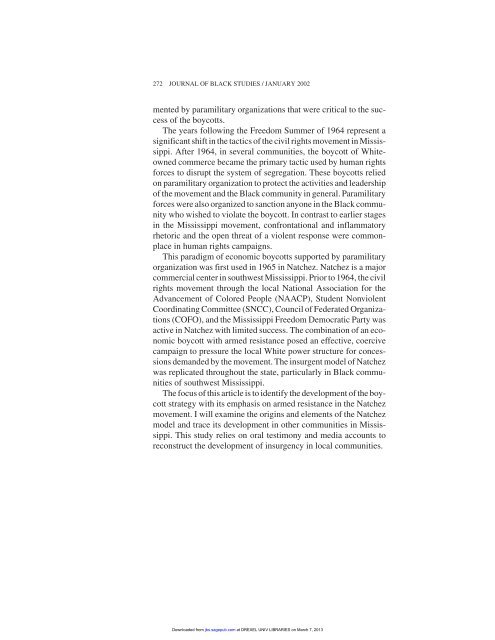MXGM Self-Defence Manual
MXGM Self-Defence Manual
MXGM Self-Defence Manual
You also want an ePaper? Increase the reach of your titles
YUMPU automatically turns print PDFs into web optimized ePapers that Google loves.
272 JOURNAL OF BLACK STUDIES / JANUARY 2002<br />
mented by paramilitary organizations that were critical to the success<br />
of the boycotts.<br />
The years following the Freedom Summer of 1964 represent a<br />
significant shift in the tactics of the civil rights movement in Mississippi.<br />
After 1964, in several communities, the boycott of Whiteowned<br />
commerce became the primary tactic used by human rights<br />
forces to disrupt the system of segregation. These boycotts relied<br />
on paramilitary organization to protect the activities and leadership<br />
of the movement and the Black community in general. Paramilitary<br />
forces were also organized to sanction anyone in the Black community<br />
who wished to violate the boycott. In contrast to earlier stages<br />
in the Mississippi movement, confrontational and inflammatory<br />
rhetoric and the open threat of a violent response were commonplace<br />
in human rights campaigns.<br />
This paradigm of economic boycotts supported by paramilitary<br />
organization was first used in 1965 in Natchez. Natchez is a major<br />
commercial center in southwest Mississippi. Prior to 1964, the civil<br />
rights movement through the local National Association for the<br />
Advancement of Colored People (NAACP), Student Nonviolent<br />
Coordinating Committee (SNCC), Council of Federated Organizations<br />
(COFO), and the Mississippi Freedom Democratic Party was<br />
active in Natchez with limited success. The combination of an economic<br />
boycott with armed resistance posed an effective, coercive<br />
campaign to pressure the local White power structure for concessions<br />
demanded by the movement. The insurgent model of Natchez<br />
was replicated throughout the state, particularly in Black communities<br />
of southwest Mississippi.<br />
The focus of this article is to identify the development of the boycott<br />
strategy with its emphasis on armed resistance in the Natchez<br />
movement. I will examine the origins and elements of the Natchez<br />
model and trace its development in other communities in Mississippi.<br />
This study relies on oral testimony and media accounts to<br />
reconstruct the development of insurgency in local communities.<br />
Downloaded from jbs.sagepub.com at DREXEL UNIV LIBRARIES on March 7, 2013


